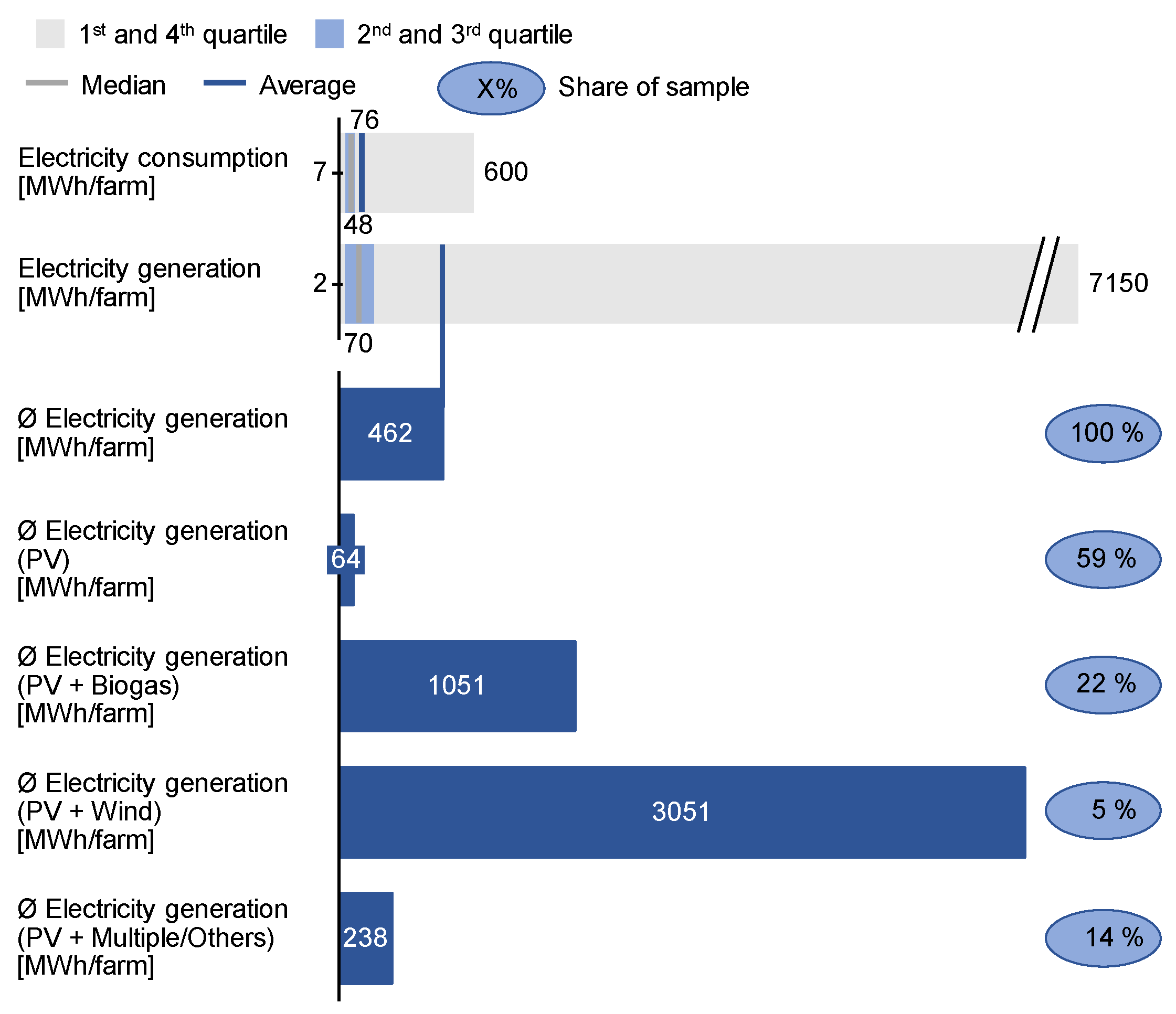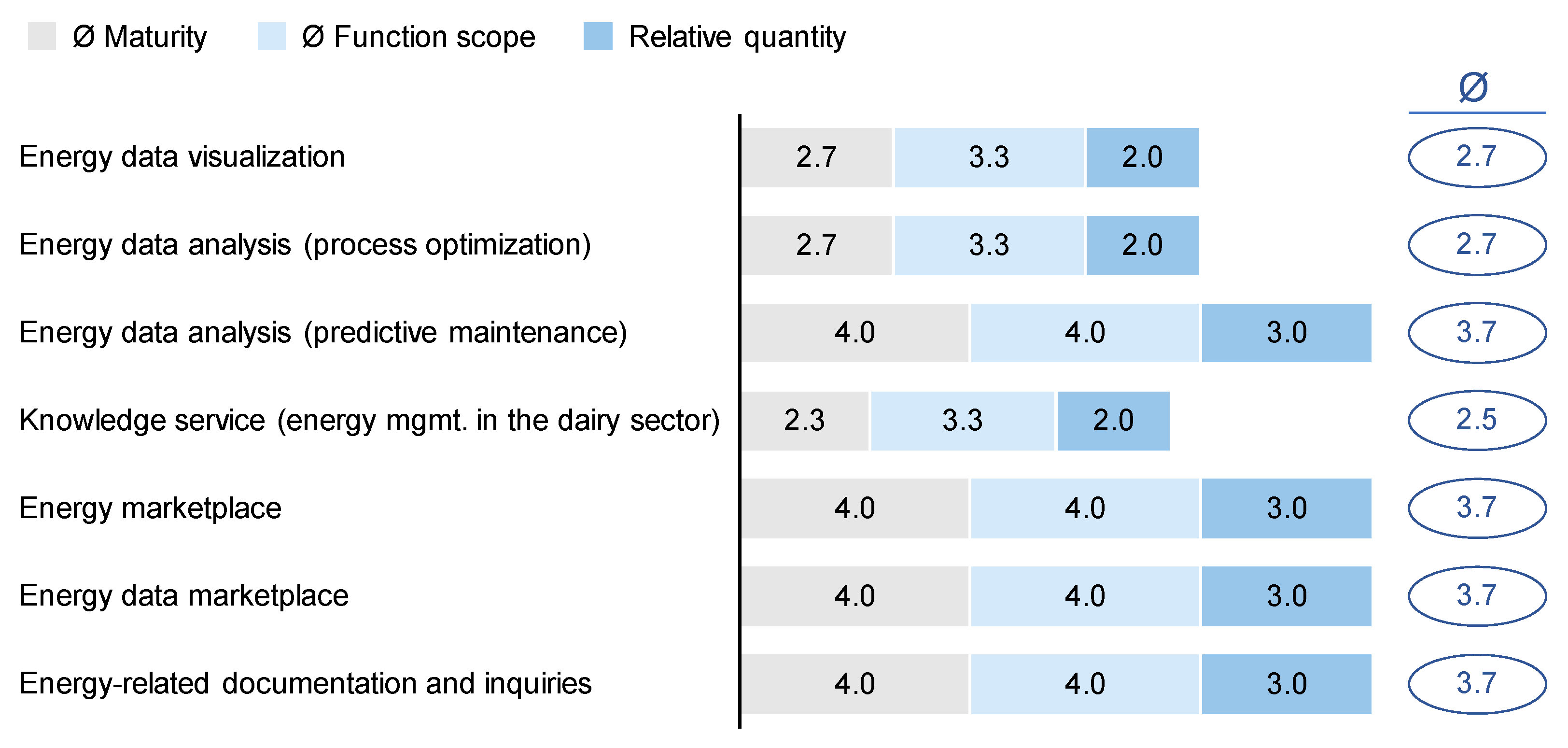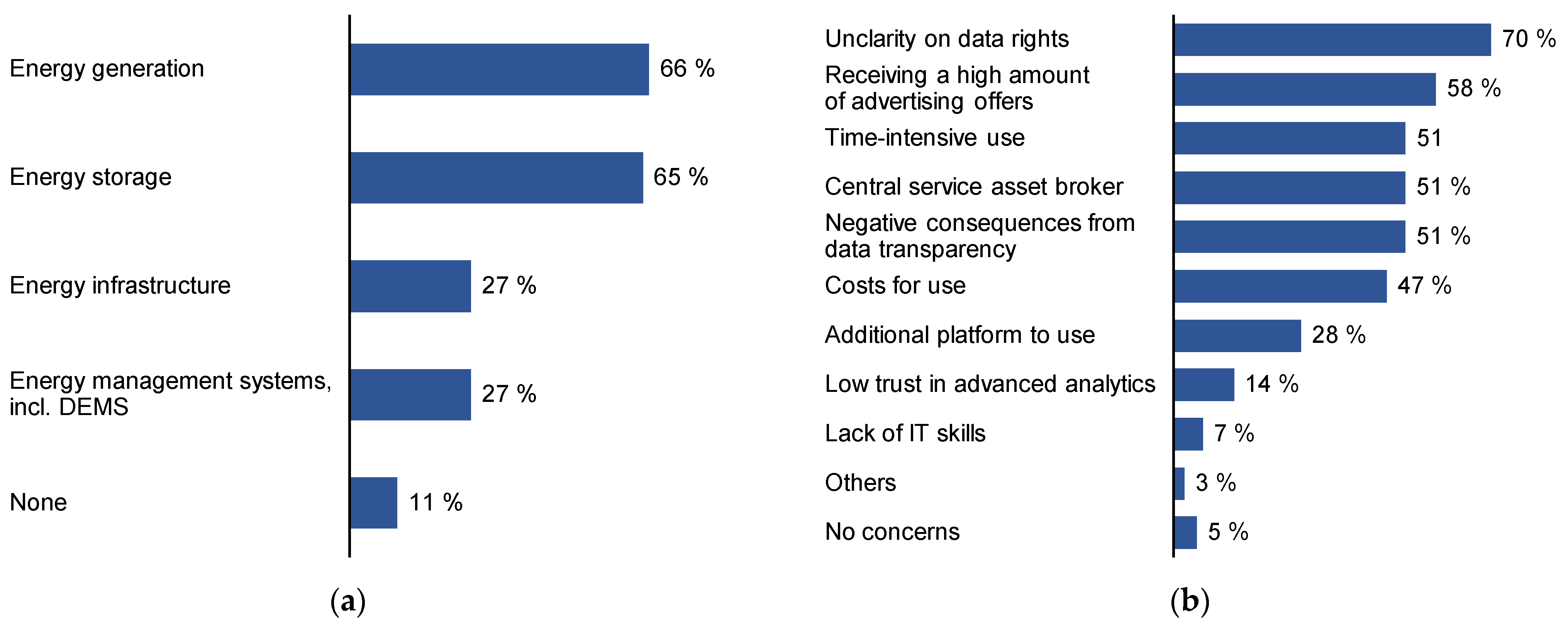Mind the Market Opportunity: Digital Energy Management Services for German Dairy Farmers
Abstract
:1. Introduction
2. Materials and Methods
2.1. Selection of DEMS and Set-Up of Our Online Survey for German Dairy Farmers
2.2. Characteristics of the Survey Sample
2.3. Approach for Screening the as-is Market Offering
3. Results
3.1. Market Relevance of DEMS for German Dairy Farms
3.2. As-is Market Offering of DEMS for German Dairy Farmers
3.3. Market Opportunity for Offering DEMS to German Dairy Farmers
4. Discussion
4.1. Investment Intentions and Concerns of German Dairy Farmers
4.2. Applicability of Our Study Results to the German Dairy Farm Population and Other Stakeholders from the Dairy Sector
4.3. Challenges when Providing DEMS to German Dairy Farmers
5. Conclusions
Author Contributions
Funding
Institutional Review Board Statement
Data Availability Statement
Conflicts of Interest
References
- Green, T.; Gourdain, E.; Hirschy, G.; Sine, M.; Geyer, M.; Laun, N.; Zude-Sasse, M.; Durner, D.; Koch, C.; Rhemouga, N.; et al. Farming System Perspective. In Handbook Digital Farming; Dörr, J., Nachtmann, M., Eds.; Springer: Berlin/Heidelberg, Germany, 2022; pp. 277–340. ISBN 978-3-662-64377-8. [Google Scholar]
- Koch, M.; Krohmer, D.; Naab, M.; Rost, D.; Trapp, M. A matter of definition: Criteria for digital ecosystems. Digit. Bus. 2022, 2, 1–13. [Google Scholar] [CrossRef]
- Dörr, J.; Nachtmann, M.; Linke, C.; Crawford, J.; Ehlers, K.; Balzer, F.; Gandorfer, M.; Gabriel, A.; Pfeiffer, J.; Spykman, O.; et al. Introduction. In Handbook Digital Farming; Dörr, J., Nachtmann, M., Eds.; Springer: Berlin/Heidelberg, Germany, 2022; pp. 1–58. ISBN 978-3-662-64377-8. [Google Scholar]
- Tummers, J.; Kassahun, A.; Tekinerdogan, B. Obstacles and features of Farm Management Information Systems: A systematic literature review. Comput. Electron. Agric. 2019, 157, 189–204. [Google Scholar] [CrossRef]
- Gabriel, A.; Gandorfer, M.; Spykman, O. Nutzung und Hemmnisse digitaler Technologien in der Landwirtschaft: Sichtweisen aus der Praxis und in den Fachmedien. Berichte über Landwirtschaft—Zeitschrift für Agrarpolitik und Landwirtschaft. Aktuelle Beitr. 2021, 99, 1–27. [Google Scholar] [CrossRef]
- Melzer, M.; Bellingrath-Kimura, S.; Gandorfer, M. Commercial Farm Management Information Systems—A Demand-Oriented Analysis of Functions in Practical Use. SSRN J. 2023, 4, 100203. [Google Scholar] [CrossRef]
- Pelegrini, D.F.; Lopes, M.A.; Demeu, F.A.; Rocha, Á.G.F.; Bruhn, F.R.P.; Casas, P.S. Effect of socioeconomic factors on the yields of family-operated milk production systems. Semina Ciênc. Agrár. 2019, 40, 1199–1213. [Google Scholar] [CrossRef] [Green Version]
- Kassahun, A.; Bloo, R.; Catal, C.; Mishra, A. Dairy Farm Management Information Systems. Electronics 2022, 11, 239. [Google Scholar] [CrossRef]
- Slob, N.; Catal, C.; Kassahun, A. Application of machine learning to improve dairy farm management: A systematic literature review. Prev. Vet. Med. 2021, 187, 105237. [Google Scholar] [CrossRef] [PubMed]
- Wijerathna-Yapa, A.; Pathirana, R. Sustainable Agro-Food Systems for Addressing Climate Change and Food Security. Agriculture 2022, 12, 1554. [Google Scholar] [CrossRef]
- Milchland Niedersachsen. Klimaplattform Milch. Available online: https://milchland.de/milchprofis/nachhaltigkeit/klimaplattform-milch/#agrarklimacheck (accessed on 11 March 2023).
- Bernhardt, H.; Höhendinger, M.; Stumpenhausen, J. Development of the Technical Structure of the “Cow Energy” Concept. Agronomy 2021, 11, 1915. [Google Scholar] [CrossRef]
- Theunissen, T.C.; Bernhardt, H. Revenue increase for German dairy farmers through cross-value chain energy management. In Proceedings of the 2022 ASABE Annual International Meeting Houston, TX, USA, 17–20 July 2022; American Society of Agricultural and Biological Engineers: St. Joseph, MI, USA, 2022. [Google Scholar]
- Zhou, K.; Fu, C.; Yang, S. Big data driven smart energy management: From big data to big insights. Renew. Sustain. Energy Rev. 2016, 56, 215–225. [Google Scholar] [CrossRef]
- Netztransparenz. Marktwertübersicht. Available online: https://www.netztransparenz.de/EEG/Marktpraemie/Marktwerte (accessed on 4 April 2023).
- Shine, P.; Upton, J.; Sefeedpari, P.; Murphy, M.D. Energy Consumption on Dairy Farms: A Review of Monitoring, Prediction Modelling, and Analyses. Energies 2020, 13, 1288. [Google Scholar] [CrossRef] [Green Version]
- Senna, P.P.; Almeida, A.H.; Barros, A.C.; Bessa, R.J.; Azevedo, A.L. Architecture Model for a Holistic and Interoperable Digital Energy Management Platform. Procedia Manuf. 2020, 51, 1117–1124. [Google Scholar] [CrossRef]
- Chen, X.; Chen, X. Data visualization in smart grid and low-carbon energy systems: A review. Int. Trans. Electr. Energ. Syst. 2021, 31, e12889. [Google Scholar] [CrossRef]
- Mohsenimanesh, A.; LeRiche, E.L.; Gordon, R.; Clarke, S.; MacDonald, R.D.; MacKinnon, I.; VanderZaag, A.C. Review: Dairy Farm Electricity Use, Conservation, and Renewable Production—A Global Perspective. Appl. Eng. Agric. 2021, 37, 977–990. [Google Scholar] [CrossRef]
- Theunissen, T.; Keller, J.; Bernhardt, H. Market gap for cross-value chain energy management in the German dairy sector. In Proceedings of the XX CIGR World Congress: Sustainable Agricultural Production—Water, Land, Energy and Food, Kyoto, Japan, 5–9 December 2022. [Google Scholar]
- Kotler, P.; Keller, K.L.; Zawiślak, M.; Środa, J. Marketing Management, Dodruk; Rebis: Poznań, Poland, 2021; ISBN 978-0-13-210292-6. [Google Scholar]
- Gerhardt, C.; Bröring, S.; Strecker, O.; Wustmans, M.; Moretti, D.; Breunig, P.; Pichon, L.; Müller-Seitz, G.; Förster, B. Framework for the Digital Transformation of the Agricultural Ecosystem. In Handbook Digital Farming; Dörr, J., Nachtmann, M., Eds.; Springer: Berlin/Heidelberg, Germany, 2022; pp. 59–108. ISBN 978-3-662-64377-8. [Google Scholar]
- FADN. Farm Accountancy Data Network (FADN) Public Database. Available online: https://agridata.ec.europa.eu/extensions/FADNPublicDatabase/FADNPublicDatabase.html (accessed on 4 March 2023).
- Arla. Arla Climate Check Report. Available online: https://www.arla.com/4a8073/globalassets/arla-global/sustainability/dairys-climate-footprint/arla-climate-check-report-2022.pdf (accessed on 9 March 2023).
- Bernhardt, H. Digitales Energiemanagement im Milchviehbereich. Inform. Spektrum 2023, 46, 3–7. [Google Scholar] [CrossRef]
- Statistisches Bundesamt. Stromverbrauch der privaten Haushalte nach Haushaltsgrößenklassen. Available online: https://www.destatis.de/DE/Themen/Gesellschaft-Umwelt/Umwelt/UGR/private-haushalte/Tabellen/stromverbrauch-haushalte.html (accessed on 9 March 2023).
- Flak, J. Technologies for Sustainable Biomass Supply—Overview of Market Offering. Agronomy 2020, 10, 798. [Google Scholar] [CrossRef]
- Khan, N.; Ray, R.L.; Kassem, H.S.; Zhang, S. Mobile Internet Technology Adoption for Sustainable Agriculture: Evidence from Wheat Farmers. Appl. Sci. 2022, 12, 4902. [Google Scholar] [CrossRef]
- Tallarida, R.J.; Murray, R.B. Chi-Square Test. In Manual of Pharmacologic Calculations; Tallarida, R.J., Murray, R.B., Eds.; Springer: New York, NY, USA, 1986; pp. 140–142. ISBN 978-1-4612-9380-4. [Google Scholar]
- Mankins, J.C. Advanced Concepts Office, Office of Space Access and Technology, NASA. In Technology Readiness Level; NASA: Washington, DC, USA, 1995. [Google Scholar]
- Munich Television. Heimatgschichtn—Beim Huabahof in Königsdorf. Available online: https://www.youtube.com/watch?v=t5HxfYU0v6Y&t=605s (accessed on 12 March 2023).
- Jung, F.; Büskens, C.; Lachmann, M. SmartFarm—Data based optimization for optimal energy management. Proc. Appl. Math. Mech. 2017, 17, 741–742. [Google Scholar] [CrossRef]
- Lindena, T.; Claus, A.S.; Johns, J.; Nieberg, H. QM-Nachhaltigkeitsmodul Milch—Es geht weiter! Available online: https://media.diemayrei.de/57/722557.pdf (accessed on 12 March 2023).
- Cells Energy. Marktplatz. Available online: https://marktplatz.cells.energy/ (accessed on 12 March 2023).
- 2G. Digitale Lösungen und Steuerungstechnik. Available online: https://2-g.com/de/produkte/digitale-und-steuerungsloesungen (accessed on 12 March 2023).
- Enertrag. Powersystem—Lassen Sie Daten sprechen. Available online: https://enertrag.com/produkte/powersystem (accessed on 12 March 2023).
- Deutscher Bauernverband. Konjunkturbarometer Agrar: Stimmungslage deutlich verschlechtert. Available online: https://www.bauernverband.de/fileadmin/user_upload/dbv/gruener_dienst/2022/KW_26_bis_KW_52/KW_41/2022_-_127_KB_September_2022_-_Charts_fuer_die_Homepage.pdf (accessed on 11 March 2023).
- Malliaroudaki, M.I.; Watson, N.J.; Ferrari, R.; Nchari, L.N.; Gomes, R.L. Energy management for a net zero dairy supply chain under climate change. Trends Food Sci. Technol. 2022, 126, 153–167. [Google Scholar] [CrossRef]
- Statista. Anzahl der Milchkühe je Betrieb in Deutschland in den Jahren 1995 bis 2022. Available online: https://de.statista.com/statistik/daten/studie/28755/umfrage/anzahl-der-milchkuehe-je-halter-in-deutschland-seit-1990/#:~:text=In%20den%20vergangenen%20Jahrzehnten%20ist,etwa%2071%20K%C3%BChe%20pro%20Betrieb (accessed on 4 April 2023).
- Kuntke, F.; Linsner, S.; Steinbrink, E.; Franken, J.; Reuter, C. Resilience in Agriculture: Communication and Energy Infrastructure Dependencies of German Farmers. Int. J. Disaster Risk Sci. 2022, 13, 214–229. [Google Scholar] [CrossRef]






| Digital Energy Management Service (DEMS) | Description |
|---|---|
| Energy data visualization | Visualization of on-farm energy data (e.g., total energy consumption and generation, energy-related costs and revenues) to increase transparency and understanding of the status quo [18] |
| Energy data analysis (process optimization) | Analysis of energy data to optimize farms’ on-site energy management, including power generation planning and efficiency improvement [14] |
| Energy data analysis (predictive maintenance) | Analysis of on-farm energy data to improve performance of farm equipment and power generators [22], including fault and outage detection [14] |
| Knowledge service (energy management in the dairy sector) | Provision of insights on the German energy market (e.g., forecasts on the electricity market prices), including relevant findings from the dairy sector (e.g., peer and industry benchmarks) [17] |
| Energy marketplace | Marketplace for trading energy with focus on selling electricity from the farm to third parties, including real-time interaction and dynamic pricing [14] |
| Energy data marketplace | Marketplace for selling energy data from the farm to stakeholders of the dairy sector and beyond (e.g., retailers, manufacturers of farm equipment, public sector) [13] |
| Energy-related documentation and inquiries | Management of energy-related files (e.g., documentation of energy data in subsidy request forms, generation of purchase requests) |
| Digital Energy Management Service (DEMS) | Age of Farmer | Dairy Herd Size | Location | Milk Yield Per Cow | Total Electricity Generation | Electricity Consumption per kg of Milk | On-Farm Electricity Utilization | Organic Farm | |||||||||
|---|---|---|---|---|---|---|---|---|---|---|---|---|---|---|---|---|---|
| <M | ≥M | <M | ≥M | Bavaria | NRW | <M | ≥M | <M | ≥M | <M | ≥M | <20% | ≥20% | Yes | No | ||
| Energy data visualization | 3.2 (46%) | 3.1 (43%) | 2.9 (45%) | 3.4 (45%) | 3.2 (54%) | 3.2 (28%) | 3.2 (46%) | 3.1 (43%) | 3.1 (47%) | 3.2 (42%) | 3.1 (47%) | 3.2 (42%) | 3.1 (55%) | 3.2 (34%) | 3.5 (18%) | 3.1 (72%) | |
| p = 0.0582 * | p = 0.3599 | ||||||||||||||||
| Energy data analysis (process optimization) | 3.4 (47%) | 3.4 (43%) | 3.4 (43%) | 3.4 (47%) | 3.4 (53%) | 3.4 (31%) | 3.3 (45%) | 3.5 (46%) | 3.4 (49%) | 3.4 (42%) | 3.4 (47%) | 3.4 (43%) | 3.3 (57%) | 3.6 (34%) | 3.6 (19%) | 3.3 (72%) | |
| Energy data analysis (predictive maintenance) | 2.7 (46%) | 2.8 (47%) | 2.6 (45%) | 2.9 (49%) | 2.7 (58%) | 3.0 (28%) | 2.6 (50%) | 2.8 (43%) | 2.8 (46%) | 2.7 (47%) | 2.6 (46%) | 2.8 (47%) | 2.7 (57%) | 2.8 (36%) | 2.8 (22%) | 2.7 (72%) | |
| p = 0.6231 | |||||||||||||||||
| Knowledge service (energy mgmt. in the dairy sector) | 3.0 (46%) | 3.3 (49%) | 3.0 (46%) | 3.3 (49%) | 3.1 (57%) | 3.2 (31%) | 3.0 (47%) | 3.3 (47%) | 3.0 (47%) | 3.3 (47%) | 3.1 (47%) | 3.2 (47%) | 3.1 (59%) | 3.2 (35%) | 3.1 (19%) | 3.2 (76%) | |
| Energy marketplace | 2.9 (46%) | 3.0 (46%) | 2.8 (45%) | 3.1 (47%) | 3.0 (45%) | 3.0 (31%) | 2.8 (45%) | 3.1 (47%) | 2.9 (46%) | 3.0 (46%) | 2.6 (45%) | 3.3 (47%) | 2.9 (57%) | 3.0 (35%) | 3.0 (19%) | 2.9 (73%) | |
| p = 0.1426 * | |||||||||||||||||
| Energy data marketplace | 2.3 (49%) | 2.1 (46%) | 2.0 (47%) | 2.4 (47%) | 2.1 (58%) | 2.4 (30%) | 2.0 (49%) | 2.4 (46%) | 2.0 (47%) | 2.3 (47%) | 2.4 (47%) | 2.0 (47%) | 2.2 (58%) | 2.2 (36%) | 2.0 (20%) | 2.2 (74%) | |
| p = 0.0811 | p = 0.5127 * | ||||||||||||||||
| Energy-related documentation and inquiries | 2.9 (46%) | 3.1 (47%) | 2.9 (45%) | 3.0 (49%) | 2.9 (55%) | 3.0 (31%) | 2.9 (47%) | 3.1 (46%) | 3.1 (46%) | 2.9 (47%) | 3.0 (47%) | 2.9 (46%) | 3.0 (59%) | 2.9 (34%) | 3.0 (19%) | 3.0 (74%) | |
| Total | 2.9 (47%) | 3.0 (46%) | 2.8 (45%) | 3.1 (47%) | 2.9 (56%) | 3.0 (30%) | 2.8 (47%) | 3.0 (46%) | 2.9 (47%) | 3.0 (46%) | 2.9 (47%) | 3.0 (46%) | 2.9 (58%) | 3.0 (35%) | 3.0 (19%) | 2.9 (73%) | |
| Assessment Dimension | Scale | |||
|---|---|---|---|---|
| 1 | 2 | 3 | 4 | |
| Maturity | TRL 9 | TRL 5–8 | TRL 2–4 | TRL 1 |
| Function scope | Comprehensive functionality | Majority of functions contained | Limited number of functions included | No functions implemented yet |
| Relative quantity | >30% | 11–30% | 1–10% | 0% |
Disclaimer/Publisher’s Note: The statements, opinions and data contained in all publications are solely those of the individual author(s) and contributor(s) and not of MDPI and/or the editor(s). MDPI and/or the editor(s) disclaim responsibility for any injury to people or property resulting from any ideas, methods, instructions or products referred to in the content. |
© 2023 by the authors. Licensee MDPI, Basel, Switzerland. This article is an open access article distributed under the terms and conditions of the Creative Commons Attribution (CC BY) license (https://creativecommons.org/licenses/by/4.0/).
Share and Cite
Theunissen, T.; Keller, J.; Bernhardt, H. Mind the Market Opportunity: Digital Energy Management Services for German Dairy Farmers. Agriculture 2023, 13, 861. https://doi.org/10.3390/agriculture13040861
Theunissen T, Keller J, Bernhardt H. Mind the Market Opportunity: Digital Energy Management Services for German Dairy Farmers. Agriculture. 2023; 13(4):861. https://doi.org/10.3390/agriculture13040861
Chicago/Turabian StyleTheunissen, Theresa, Julia Keller, and Heinz Bernhardt. 2023. "Mind the Market Opportunity: Digital Energy Management Services for German Dairy Farmers" Agriculture 13, no. 4: 861. https://doi.org/10.3390/agriculture13040861






